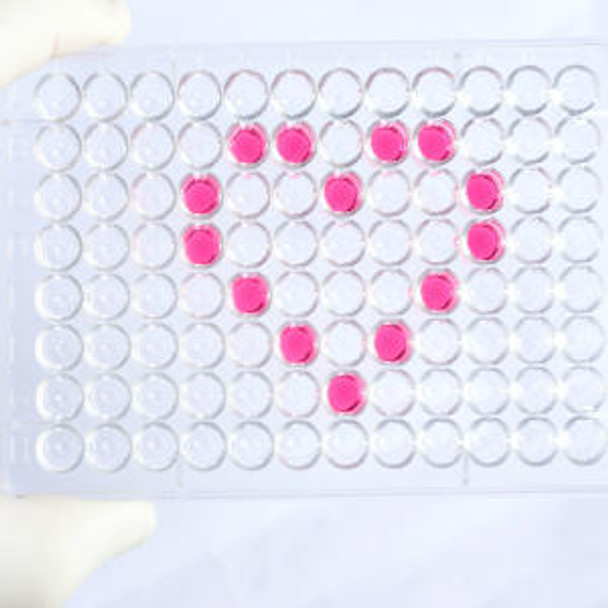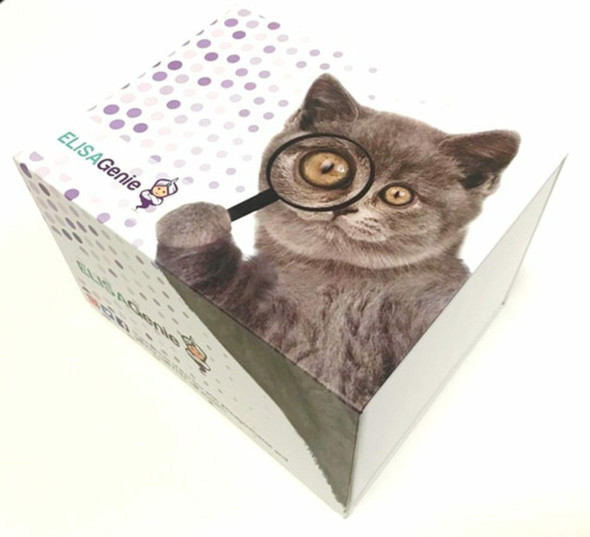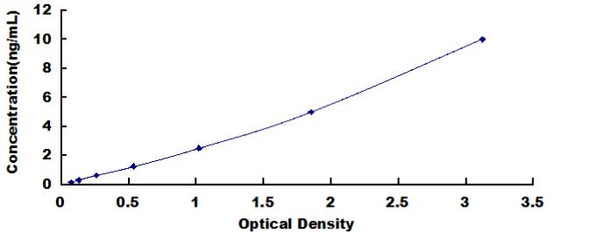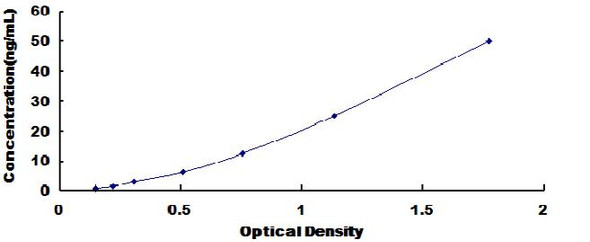Human FAS-associated factor 2 (FAF2) ELISA Kit (HUEB2515)
- SKU:
- HUEB2515
- Product Type:
- ELISA Kit
- Size:
- 96 Assays
- Uniprot:
- Q96CS3
- Range:
- 0.156-10 ng/mL
- ELISA Type:
- Sandwich
- Synonyms:
- FAF2, ETEA, KIAA0887, UBXD8, UBXN3B, UBX domain-containing protein 8, Protein ETEA, UBX domain-containing protein 3B
- Reactivity:
- Human
Description
Human FAS-associated factor 2 (FAF2) ELISA Kit
The Human FAS-Associated Factor 2 (FAF2) ELISA Kit is a highly reliable and precise tool for quantifying FAF2 levels in human biological samples such as serum, plasma, and cell culture supernatants. With its superior sensitivity and specificity, this ELISA kit delivers accurate and reproducible results, making it an invaluable asset for a wide range of research applications.FAF2 is a critical protein that plays a key role in regulating cell death and is involved in various cellular processes.
Dysregulation of FAF2 has been linked to several diseases, including cancer and neurodegenerative disorders, making it a valuable biomarker for studying these conditions and potentially identifying therapeutic targets.Overall, the Human FAS-Associated Factor 2 (FAF2) ELISA Kit provides researchers with a powerful tool for investigating the role of FAF2 in health and disease, paving the way for new insights and potential treatments in the field of molecular biology and medicine.
| Product Name: | Human FAS-associated factor 2 (FAF2) ELISA Kit |
| SKU: | HUEB2515 |
| Size: | 96T |
| Target: | Human FAS-associated factor 2 (FAF2) |
| Synonyms: | Protein ETEA, UBX domain-containing protein 3B, UBX domain-containing protein 8, ETEA, KIAA0887, UBXD8, UBXN3B |
| Assay Type: | Sandwich |
| Detection Method: | ELISA |
| Reactivity: | Human |
| Detection Range: | 0.156-10ng/mL |
| Sensitivity: | 0.056ng/mL |
| Intra CV: | 6.2% | ||||||||||||||||||||
| Inter CV: | 11.5% | ||||||||||||||||||||
| Linearity: |
| ||||||||||||||||||||
| Recovery: |
| ||||||||||||||||||||
| Function: | Plays an important role in endoplasmic reticulum-associated degradation (ERAD) that mediates ubiquitin-dependent degradation of misfolded endoplasmic reticulum proteins (PubMed:18711132, PubMed:24215460). Involved in inhibition of lipid droplet degradation by binding to phospholipase PNPL2 and inhibiting its activity by promoting dissociation of PNPL2 from its endogenous activator, ABHD5 which inhibits the rate of triacylglycerol hydrolysis (PubMed:23297223). |
| Uniprot: | Q96CS3 |
| Sample Type: | Serum, plasma, tissue homogenates, cell culture supernates and other biological fluids |
| Specificity: | Natural and recombinant human FAS-associated factor 2 |
| Sub Unit: | Identified in a complex that contains SEL1L, OS9, FAF2/UBXD8, UBE2J1/UBC6E and AUP1 (PubMed:18711132). Interacts with YOD1 (PubMed:19818707). Interacts (via N-terminus) with UBQLN2 (via C-terminus) (PubMed:24215460). Interacts with PNPLA2 and UBAC2 (PubMed:23297223). |
| Subcellular Location: | Cytoplasm Lipid droplet Endoplasmic reticulum |
| Storage: | Please see kit components below for exact storage details |
| Note: | For research use only |
| UniProt Protein Function: | ETEA: May play a role in the translocation of terminally misfolded proteins from the endoplasmic reticulum lumen to the cytoplasm and their degradation by the proteasome. |
| UniProt Protein Details: | Protein type:Ubiquitin conjugating system Chromosomal Location of Human Ortholog: 5q35.2 Cellular Component: intracellular membrane-bound organelle; endoplasmic reticulum; lipid particle Molecular Function:protein binding; ubiquitin binding; lipase inhibitor activity; ubiquitin protein ligase binding Biological Process: negative regulation of catalytic activity; response to unfolded protein |
| NCBI Summary: | The protein encoded by this gene is highly expressed in peripheral blood of patients with atopic dermatitis (AD), compared to normal individuals. It may play a role in regulating the resistance to apoptosis that is observed in T cells and eosinophils of AD patients. [provided by RefSeq, Jul 2008] |
| UniProt Code: | Q96CS3 |
| NCBI GenInfo Identifier: | 74731375 |
| NCBI Gene ID: | 23197 |
| NCBI Accession: | Q96CS3.2 |
| UniProt Secondary Accession: | Q96CS3,O94963, Q8IUF2, Q9BRP2, Q9BVM7, |
| UniProt Related Accession: | Q96CS3 |
| Molecular Weight: | 52,623 Da |
| NCBI Full Name: | FAS-associated factor 2 |
| NCBI Synonym Full Names: | Fas associated factor family member 2 |
| NCBI Official Symbol: | FAF2 |
| NCBI Official Synonym Symbols: | ETEA; UBXD8; UBXN3B |
| NCBI Protein Information: | FAS-associated factor 2; UBX domain containing 8; UBX domain protein 3B; UBX domain-containing protein 3B; UBX domain-containing protein 8; expressed in T-cells and eosinophils in atopic dermatitis |
| UniProt Protein Name: | FAS-associated factor 2 |
| UniProt Synonym Protein Names: | Protein ETEA; UBX domain-containing protein 3B; UBX domain-containing protein 8 |
| Protein Family: | FAS-associated factor |
| UniProt Gene Name: | FAF2 |
| UniProt Entry Name: | FAF2_HUMAN |
| Component | Quantity (96 Assays) | Storage |
| ELISA Microplate (Dismountable) | 8×12 strips | -20°C |
| Lyophilized Standard | 2 | -20°C |
| Sample Diluent | 20ml | -20°C |
| Assay Diluent A | 10mL | -20°C |
| Assay Diluent B | 10mL | -20°C |
| Detection Reagent A | 120µL | -20°C |
| Detection Reagent B | 120µL | -20°C |
| Wash Buffer | 30mL | 4°C |
| Substrate | 10mL | 4°C |
| Stop Solution | 10mL | 4°C |
| Plate Sealer | 5 | - |
Other materials and equipment required:
- Microplate reader with 450 nm wavelength filter
- Multichannel Pipette, Pipette, microcentrifuge tubes and disposable pipette tips
- Incubator
- Deionized or distilled water
- Absorbent paper
- Buffer resevoir
*Note: The below protocol is a sample protocol. Protocols are specific to each batch/lot. For the correct instructions please follow the protocol included in your kit.
Allow all reagents to reach room temperature (Please do not dissolve the reagents at 37°C directly). All the reagents should be mixed thoroughly by gently swirling before pipetting. Avoid foaming. Keep appropriate numbers of strips for 1 experiment and remove extra strips from microtiter plate. Removed strips should be resealed and stored at -20°C until the kits expiry date. Prepare all reagents, working standards and samples as directed in the previous sections. Please predict the concentration before assaying. If values for these are not within the range of the standard curve, users must determine the optimal sample dilutions for their experiments. We recommend running all samples in duplicate.
| Step | |
| 1. | Add Sample: Add 100µL of Standard, Blank, or Sample per well. The blank well is added with Sample diluent. Solutions are added to the bottom of micro ELISA plate well, avoid inside wall touching and foaming as possible. Mix it gently. Cover the plate with sealer we provided. Incubate for 120 minutes at 37°C. |
| 2. | Remove the liquid from each well, don't wash. Add 100µL of Detection Reagent A working solution to each well. Cover with the Plate sealer. Gently tap the plate to ensure thorough mixing. Incubate for 1 hour at 37°C. Note: if Detection Reagent A appears cloudy warm to room temperature until solution is uniform. |
| 3. | Aspirate each well and wash, repeating the process three times. Wash by filling each well with Wash Buffer (approximately 400µL) (a squirt bottle, multi-channel pipette,manifold dispenser or automated washer are needed). Complete removal of liquid at each step is essential. After the last wash, completely remove remaining Wash Buffer by aspirating or decanting. Invert the plate and pat it against thick clean absorbent paper. |
| 4. | Add 100µL of Detection Reagent B working solution to each well. Cover with the Plate sealer. Incubate for 60 minutes at 37°C. |
| 5. | Repeat the wash process for five times as conducted in step 3. |
| 6. | Add 90µL of Substrate Solution to each well. Cover with a new Plate sealer and incubate for 10-20 minutes at 37°C. Protect the plate from light. The reaction time can be shortened or extended according to the actual color change, but this should not exceed more than 30 minutes. When apparent gradient appears in standard wells, user should terminatethe reaction. |
| 7. | Add 50µL of Stop Solution to each well. If color change does not appear uniform, gently tap the plate to ensure thorough mixing. |
| 8. | Determine the optical density (OD value) of each well at once, using a micro-plate reader set to 450 nm. User should open the micro-plate reader in advance, preheat the instrument, and set the testing parameters. |
| 9. | After experiment, store all reagents according to the specified storage temperature respectively until their expiry. |
When carrying out an ELISA assay it is important to prepare your samples in order to achieve the best possible results. Below we have a list of procedures for the preparation of samples for different sample types.
| Sample Type | Protocol |
| Serum | If using serum separator tubes, allow samples to clot for 30 minutes at room temperature. Centrifuge for 10 minutes at 1,000x g. Collect the serum fraction and assay promptly or aliquot and store the samples at -80°C. Avoid multiple freeze-thaw cycles. If serum separator tubes are not being used, allow samples to clot overnight at 2-8°C. Centrifuge for 10 minutes at 1,000x g. Remove serum and assay promptly or aliquot and store the samples at -80°C. Avoid multiple freeze-thaw cycles. |
| Plasma | Collect plasma using EDTA or heparin as an anticoagulant. Centrifuge samples at 4°C for 15 mins at 1000 × g within 30 mins of collection. Collect the plasma fraction and assay promptly or aliquot and store the samples at -80°C. Avoid multiple freeze-thaw cycles. Note: Over haemolysed samples are not suitable for use with this kit. |
| Urine & Cerebrospinal Fluid | Collect the urine (mid-stream) in a sterile container, centrifuge for 20 mins at 2000-3000 rpm. Remove supernatant and assay immediately. If any precipitation is detected, repeat the centrifugation step. A similar protocol can be used for cerebrospinal fluid. |
| Cell culture supernatant | Collect the cell culture media by pipette, followed by centrifugation at 4°C for 20 mins at 1500 rpm. Collect the clear supernatant and assay immediately. |
| Cell lysates | Solubilize cells in lysis buffer and allow to sit on ice for 30 minutes. Centrifuge tubes at 14,000 x g for 5 minutes to remove insoluble material. Aliquot the supernatant into a new tube and discard the remaining whole cell extract. Quantify total protein concentration using a total protein assay. Assay immediately or aliquot and store at ≤ -20 °C. |
| Tissue homogenates | The preparation of tissue homogenates will vary depending upon tissue type. Rinse tissue with 1X PBS to remove excess blood & homogenize in 20ml of 1X PBS (including protease inhibitors) and store overnight at ≤ -20°C. Two freeze-thaw cycles are required to break the cell membranes. To further disrupt the cell membranes you can sonicate the samples. Centrifuge homogenates for 5 mins at 5000xg. Remove the supernatant and assay immediately or aliquot and store at -20°C or -80°C. |
| Tissue lysates | Rinse tissue with PBS, cut into 1-2 mm pieces, and homogenize with a tissue homogenizer in PBS. Add an equal volume of RIPA buffer containing protease inhibitors and lyse tissues at room temperature for 30 minutes with gentle agitation. Centrifuge to remove debris. Quantify total protein concentration using a total protein assay. Assay immediately or aliquot and store at ≤ -20 °C. |
| Breast Milk | Collect milk samples and centrifuge at 10,000 x g for 60 min at 4°C. Aliquot the supernatant and assay. For long term use, store samples at -80°C. Minimize freeze/thaw cycles. |









